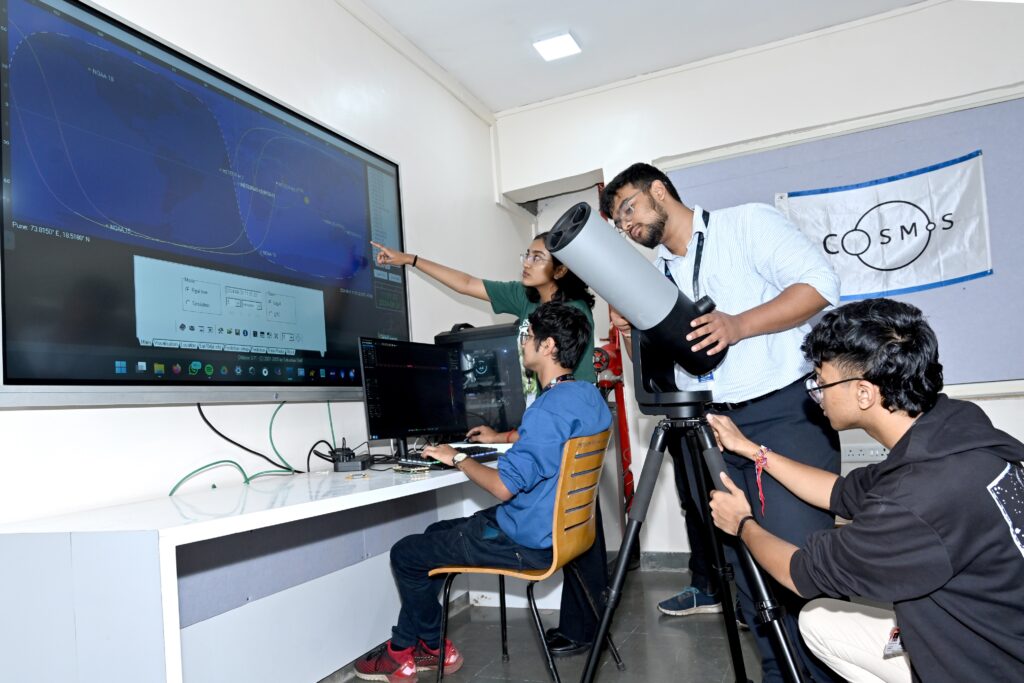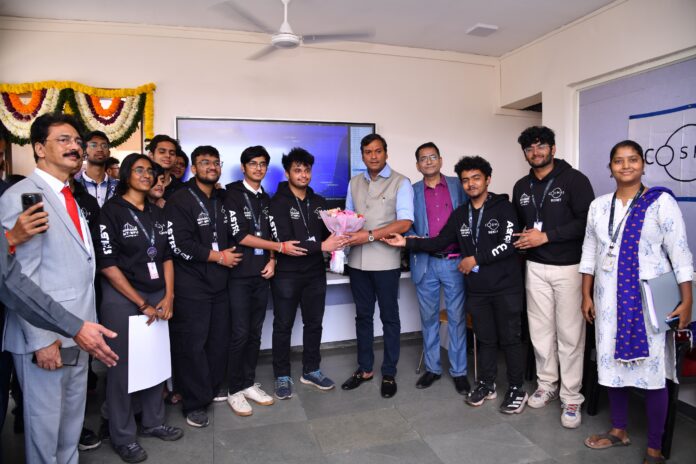The capability to handle complex tasks of satellite communication (downlink) and cosmic observation simultaneously makes it a rare facility in the world
09 September 2024/ PUNE: MIT World Peace University (MIT-WPU) has established a state-of-the-art Ground Station at its Pune campus as part of the institution’s nano-satellite initiative and Radio Astronomy. Inaugurated by Mr. Rahul Karad, Executive President of MIT-WPU, the one-of-its-kind facility, capable of both satellite reception and radio astronomy, will provide valuable data for enhancing radio astronomy research and improving satellite communications capabilities.
Said Prof. Dr. Milind Pande, Pro Vice Chancellor, MIT World Peace University, “This cutting-edge Ground Station embodies a new approach to satellite communication and radio astronomy, offering dual capabilities that set it apart globally. The ability to communicate with satellites on one hand and study emissions from cosmic bodies on the other is a great way to leverage technology and research for multiple purposes. Working on this project would serve as a valuable learning experience for MIT-WPU students and prepare them for careers in astronomy, aerospace and related fields. It is also meant to be a practical stepping stone for them to design and launch a nanosatellite in near future.”

Added Dr. Anup Kale, Associate Dean, School of Science & Environmental Studies, MIT-WPU. “The primary purpose of the Ground Station is to bridge the gap between theoretical knowledge and practical application. By providing our students hands-on experience with satellite communication and radio astronomy. The facility will be used for a variety of critical functions, including receiving and analysing data from open-source satellites. To support research in fields such as climate science, disaster management, and space exploration. It will also enable study of cosmic emissions, contributing valuable insights into the behaviour of celestial bodies.”
The Ground Station consists of six different antennae designed to receive signals from satellites in Low Earth Orbit (LEO). Medium Earth Orbit (MEO), High Elliptical Orbit (HEO) and Geostationary Earth Orbit (GEO). Specialized dish and horn antennas enable the reception of high-frequency signals. Transforming it into a powerful Radio Astronomy tool and enabling the study of the universe’s most minute signals, galaxy mapping, dark matter, and radio imagery of the cosmos. The Ground Station can receive signals from open-source satellites to collect weather data. As well as telemetry from CubeSats, Nanosats, and Microsats.
Top Courses in Project Management
Students of the varsity’s Cosmos Club, dedicated to nurturing the curiosity and passion of amateur astronomers, are actively involved in the Ground Station. Said Ojas Dhumal, a third-year Mechanical Engineering student at MIT-WPU and member of the Cosmos Club. “The facility’s control room can simultaneously handle complex tasks of satellite communication (downlink) and cosmic observation. This unique combination is rare. The Ground Station is currently in contact with NOAA and Meteor satellites, receiving data. That helps us understand and respond to weather patterns and track environmental changes. It has successfully done reception from the International Space Station several times.”
The students are also preparing to upload data to various satellites as part of hands-on learning experience. Following their acquisition of a HAM (amateur radio) license.
A team of 35 MIT-WPU students is working on the project along with 4 faculty members. Including Dr. Anup Kale, Associate Dean, School of Science & Environmental Studies, and Prof. Anagha Karne. Dr. Deobrat Singh and Dr. Sachin Kulkarni from Department of Physics under the varsity’s School of Science & Environmental Studies.
ABOUT MIT-WPU
MIT World Peace University (MIT-WPU), Pune, is a prestigious world-class institution of higher education in India. Embodying a distinguished legacy of 40+ years and committed to nurturing academic excellence. With an expansive global alumni network exceeding 1,00,000 accomplished professionals, MIT-WPU consistently demonstrates exceptional educational achievements. The university remains at the forefront of academic innovation, offering a comprehensive study of over 150 undergraduate and postgraduate programmes. Each meticulously crafted to blend theoretical foundations with practical application.
Embracing an educational philosophy centred on experiential learning. MIT-WPU empowers students to transition knowledge into tangible skills for the real world seamlessly. Immersive internships and invaluable mentorship opportunities further reinforce this ethos, catalysing profound personal and professional development.
ALSO READ: Tata AIG General Insurance and Manipal Academy of BFSI Launch Job-Assured Program for Future Talent
We envision a future powered by education, innovation, and culture. One that is sustainable, inclusive, and fosters progressive societal transformation (“Powering The Future”). To achieve this, we cultivate a culture of excellence with three pillars: fostering exemplary leadership. Prioritising empathy and improving the present for all, and emphasising interdisciplinary collaboration in our educational approach. Ultimately, we believe that true global peace and harmony can be reached through the concordant integration of Science and Spirituality.
For more information related to technology, visit: HawksCode and EasyShiksha


































































